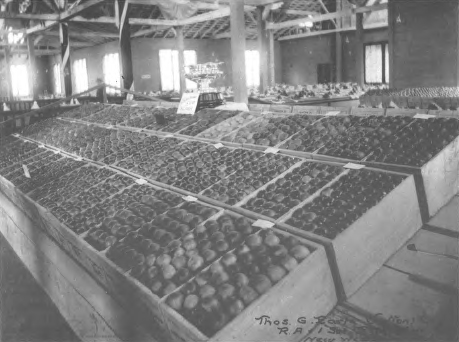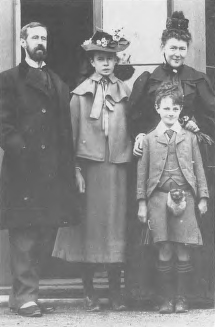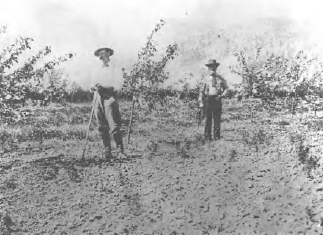News & Events More |
Growth of the OkanaganIf Father Pandosy was the "Father of Okanagan Fruit Growing", the Earl of Aberdeen was at least a foster-parent, for he was the first to plant sufficiently large acreages of fruit to constitute a commercial test. Lord and Lady Aberdeen travelled through Canada to the West Coast in October of 1890. They were looking for an estate on which to place Coutts Majoribanks, Lady Aberdeen's somewhat ne'er-do-well brother. After rejecting various properties in the Fraser Valley as too expensive, they were persuaded by G.G. McKay to buy, sight unseen, the 480 acre McDougall Ranch near the Okanagan Mission for $10,000. They renamed the ranch Guisachan, in honour of the Scottish estate of Lady Aberdeen's father. When, the following year, the Aberdeens visited their new property, the Earl was so taken with the Okanagan that he bought the 13,000-acre Coldstream Ranch, for the sum of £49,000, from Forbes George Vernon, the local MLA and provincial Chief Commissioner of Lands. The Aberdeens were immediately enthusiastic (they were enthusiasts by nature) about the potential of fruit growing. Lady Aberdeen recorded in her journal the productivity of a small orchard neighbouring the Guisachan property: They have one-third of an acre planted with twenty-four apple trees, some old, some only 4 years old. Last year, after his children, men etc. having lived off apples until the men complained and all picking as many as they chose, he sold 250 dollars worth at 4 cents per lb. So please now calculate what 200 acres planted with apple trees would bring in according to this. Or calculate that they will only bring in half that amount and then say if our farm is not going to pay, even with apples alone. Not that we mean to satisfy ourselves only with apples. Pears, plums, cherries, and then all the small fruits which will bear in the second year and so save much waiting. There is an unlimited demand for fruit in the North West, but we are not going to risk the dangers of travelling for the small fruit.
So orchards were laid out on the Aberdeen estates in 1892-100 acres each at Guisachan and Coldstream, where the planting included 150 peaches, 50 apricots, 3000 apples (mostly Northern Spy and Wealthy), 100 crabapples, 200 prunes, 300 plums, 500 cherries, 5000 raspberry canes, and 10,000 strawberry plants. With increasing enthusiasm, Aberdeen built a jam factory at Vernon to process the huge amounts of small fruits he expected would now be grown in the area, and subdivided part of his Coldstream property into parcels of twenty acres and up, for sale to prospective fruit growers.” By November, 1893, he had sold 900 acres. At first, Aberdeen's orchards seemed to prosper. Following his example, other commercial orchards were set out, such as those of the Barnard brothers near Vernon (75 acres) and of J.L. Pridham at Okanagan Mission (35 acres). Most other ranchers and farmers in the Okanagan planted their own smaller orchards. Lord and Lady Aberdeen and children. Courtesy Vernon Museum and Archives Those who wanted to plant commercial orchards could not always get hold of suitable land, because the cattle ranchers had little desire to break up their holdings. The poet, Charles Mair, who ran stores at Benvoulin and Kelowna between 1892 and 1896, complained: What with fruit, fine vegetables such as tomatoes, hops, vines & wine-growing, this region will be an exceedingly rich one. The one draw back is that a lot of political shysters at Victoria and old chaps who packed in over the mountains from Oregon and Washington many years ago have got hold of all the best land, both bottom and mountain. . . . the sooner the country is municipalized the better so that they may be forced to sell to better men. Some people would have liked greatly to oblige Mair, especially those who would have profited as agents in selling subdivided land. Companies were formed to develop townsites at Penticton in 1892, and at Okanagan Falls in 1893, but both developments foundered because Thomas Ellis, the cattle rancher whose property surrounded both sites, declined to sell land for subdivision. In the Coldstream Orchard, 1892. Courtesy Kelowna Centennial Museum The developers were not helped by the continent-wide economic depression which started late in 1893 and continued for six years. This depression meant that many of those who might have wanted to become fruit growers were unable to raise the considerable capital necessary. Lady Aberdeen, for example, wrote that the prospective orchardist should have a capital of at least £500, in order to buy twenty acres, plant it, build a house on it, and live for the four or five years before the trees produced a crop. Orcharding was further discouraged by the failure of Lord Aberdeen's orchards to live up to expectations. Sufficient care had not been taken with them, and by 1895 the Guisachan planting was in serious trouble. The alkaline soil and a high water table meant that the land was not really suitable for fruit. An agricultural expert reported the major problem was that: Numbers of fruit trees on the Guisichan [sic] property had been very badly planted, either with the roots in bunches or too deeply, and there had been a want of cultivation and neglect of pruning and spraying. Whatever the reason, the entire Guisachan orchard had to be pulled out in 1896. The problems at Coldstream were less severe, but much replanting was necessary. Not until the turn of the century, when the replanted areas came into bearing, could the Coldstream Estate again be cited as an example of successful orcharding. These difficulties, and other problems of organization, transportation, and marketing, resulted in the end of the burst of energy which had begun in 1890. T.W. Stirling, an early developer and orchardist (president of the B.C.F.G.A. in 1905), wrote in 1909: The first orchards planted for commercial purposes at Kelowna . . . were planted 18 years ago [1891]. There was some planting also during the next year or two . . . the few orchards of this period [total] perhaps less than 150 acres . . . After this there was very little planting done until about six years ago [1903] . . . Contact Us Hours: 9am - 4pm weekdays. t: 250-762-5226 |




